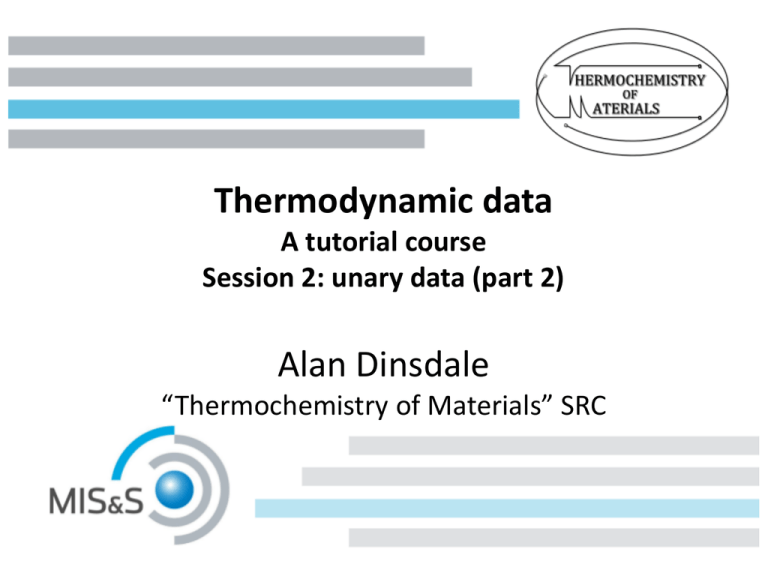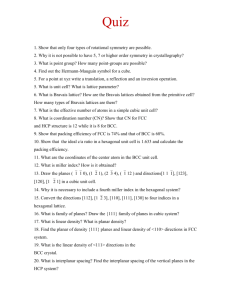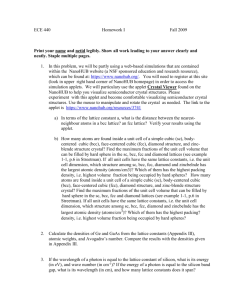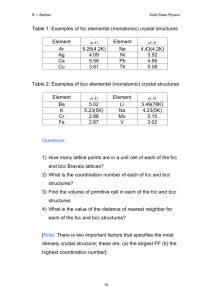Thermodynamic_data_2
advertisement

Thermodynamic data A tutorial course Session 2: unary data (part 2) Alan Dinsdale “Thermochemistry of Materials” SRC Review • The aim was to give you some experience in handling data – Conversion of data from one format to another – Calculation of unary phase diagram – Estimation of lattice stabilities Heat capacity data for KCl Deltaf H S298 -436684.1 a 82.555 bT c T^2 50.47661 0.005924377 Upper Temperature Limit Enthalpy change dT^(-2) 7.49668E-06 -144173.9 700 0 143.5698 -0.1680399 9.9657E-05 -8217836 1044 26283.9 73.59656 0 0 0 2000 0 • Convert these data to G-Hser • Hint : Start with the low temperature range. Use the equations for Cp given in slide 11 and equate them to the coefficients in the above table. Then include ΔfH298 and S298 • Then go to the second temperature range. Adjust the first and second coefficient to make sure that H and S are the same as line 1 at the temperature limit • Then go to the third range but this time include also the enthalpy and temperature of transition The answers A BT C T ln(T) d T^2 e T^3 Upper temperature limit f T^(-1) -4.525468E+05 2.584275E+02 -5.047661E+01 -2.962189E-03 -1.249447E-06 7.208695E+04 700 -4.971616E+05 8.704243E+02 -1.435698E+02 8.401995E-02 -1.660950E-05 4.108918E+06 1044 -4.437308E+05 4.062578E+02 -7.359656E+01 2000 0 0 0 Phase diagram for KCl • Calculate the phase diagram for KCl between 300 to 1800 K, 0 to 3 GPa • We have three phases: HALITE, LIQUID and CSCL • We can take the HALITE phase as the reference phase. The data for the other phases will be relative to that and will take the form A+BT+CP • HALITE: G=0 • LIQUID: G = 26284-25.17624521*T+3.69441e-6*P • CSCL: G = 3207.841581-0.078831938*T-1.592096e-6*P • what value do you calculate for the triple point when all three phases are in equilibrium ? • Hint: The boundary between HALITE and the LIQUID and CSCL phases is given by setting the appropriate Gibbs energy expression to zero and then expressing T as a function of P Lattice stability data for bct Ga • Bct_a5 is the phase labelled as II on the next slide • Derive lattice stability data for this bct_a5 phase • Hint: extrapolate the phase boundaries between phase II and liquid, and phase II and phase I (ortho_Ga). These temperatures can be marked on the next diagram and a straight line can drawn between them to show how the Gibbs energy of this bct_a5 phase varies with temperature Phase diagram for Ga Gibbs energy differences for Ga This session will be concerned with: • Unary data (part II) – Magnetic model – Pressure dependence – Lattice stabilities – Unstable phases Magnetics • Model we generally use for magnetic contribution to thermodynamic properties from Hillert and Jarl based on work by Inden 𝐺𝑚𝑎𝑔 = 𝑅 𝑇 ln 𝐵0 + 1 𝑔 𝜏 • Where 𝜏 = 𝑇 𝑇 ∗ • T* the critical temperature – TC, the Curie temperature for ferromagnetic materials – TN, the Neel temperature for antiferromagnetic materials • B0 is the average magnetic moment per atom Magnetic materials • Bcc Fe (TC = 1043 K) – therefore all ferritic steels • Fcc Ni (TC = 633 K) – therefore most austenitic steels and superalloys • Co (hcp, fcc), Mn (cbcc, fcc, bcc), Dy (hcp), Gd (hcp), Fe3O4 𝐺𝑚𝑎𝑔 = 𝑅 𝑇 ln 𝐵0 + 1 𝑔 𝜏 79𝜏 −1 474 1 𝑔 𝜏 =1− + −1 140 𝑝 497 𝑝 𝜏3 𝜏9 𝜏 15 + + 6 135 600 𝜏 −5 𝜏 −15 𝜏 −25 𝑔 𝜏 =− + + /𝐷 10 315 1500 /𝐷 𝜏≤1 𝜏>1 518 11692 1 𝐷= + −1 1125 15975 𝑝 • p can be thought of as the fraction of the magnetic enthalpy absorbed above the critical temperature – Usually taken to be 0.4 for bcc_a2 and 0.28 for other common phases Entropy contribution 𝑆𝑚𝑎𝑔 = −𝑅 ln 𝐵0 + 1 𝑓 𝜏 474 1 𝑓 𝜏 =1− −1 497 𝑝 2𝜏 3 2𝜏 9 2𝜏 15 + + 3 27 75 2𝜏 −5 2𝜏 −15 2𝜏 −25 𝑓 𝜏 = + + /𝐷 5 45 125 /𝐷 𝜏≤1 τ>1 Enthalpy contribution 𝐻𝑚𝑎𝑔 = 𝑅 𝑇 ln 𝐵0 + 1 ℎ 𝜏 where 79𝜏 −1 474 1 ℎ 𝜏 = − + −1 140𝑝 497 𝑝 𝜏 3 𝜏 9 𝜏 15 + + 2 15 40 𝜏 −5 𝜏 −15 𝜏 −25 ℎ 𝜏 =− + + /𝐷 2 21 60 /𝐷 𝜏>1 𝜏≤1 Heat capacity contribution 𝐶𝑝𝑚𝑎𝑔 = 𝑅 ln 𝐵0 + 1 𝑐 𝜏 where 474 1 𝑐 𝜏 = −1 497 𝑝 9 15 2𝜏 2𝜏 2𝜏 3 + + 3 5 −15 −25 2𝜏 2𝜏 𝑐 𝜏 = 2𝜏 −5 + + /𝐷 3 5 /𝐷 𝜏 ≤ 1 𝜏>1 Heat capacity of bcc Fe Gibbs energy differences for Fe Enthalpy differences for Fe: ref fcc Pressure dependence • Our basic Equation of State 𝐺 =𝐻 −𝑇𝑆+𝑃𝑉 • The PV term can be quite complicated as the volume will vary both with temperature and pressure • For relatively modest pressures the volume can be represented by 𝑎1 𝑇 2 𝑎2 𝑇 3 𝑉 = 𝐴 1 + 𝑎0 𝑇 + + + 𝑎3 𝑇 −1 2 3 • And the compressibility by 𝜅 = 𝐾0 + 𝐾1 𝑇 + 𝐾2 𝑇 2 • One way of combining these is in terms of the so called Murnaghan model 𝐺𝑝𝑟𝑒𝑠 𝑎1 𝑇 2 𝑎2 𝑇 3 𝐴 𝑒𝑥𝑝 𝑎0 𝑇 + 2 + 3 + 𝑎3 𝑇 −1 = 𝐾0 + 𝐾1 𝑇 + 𝐾2 𝑇 2 𝑛 − 1 (1 + 𝑛𝑃 𝐾0 + 𝐾1 𝑇 + 𝐾2 𝑇 2 )1−1/𝑛 − 1 T-P phase diagram for Fe Lattice stabilities: Difference in Gibbs energies between phases • Often we are interested in the thermodynamic properties of phases outside the region where they are stable – Eutectics – we would like to have data for liquid Ag and Cu at 780°C – well below the melting points of the elements – Solubility – in order to model the Fe-Cr phase diagram we need data for Cr in austenite (fcc). The only stable solid phase of Cr is bcc. Therefore we need to derive data for fcc Cr Extrapolation of P-T phase diagrams Extrapolation of binary phase diagrams Cr-Ni Cr-Ni thermodynamic properties Trends in entropies of fusion: fcc Trends in entropies of fusion: hcp Trends in entropies of fusion: bcc Trends across transition metal series Trends across transition metal series Trends across transition metal series Trends down a series in the periodic table Use of ab initio calculations • The present set of element data were derived largely from experimental data. Ab initio calculations were not thought to be sufficiently accurate in 1991 • Now we have much more confidence in ab initio calculations. They can be used for calculation of enthalpy differences between phases and entropy of phases at 25°C • However ab initio has also told us that some phases of elements are mechanically unstable eg. Fcc Cr, fcc W, even bcc Ti at low temperatures • This calls into question the very basis behind lattice stabilities Next session • This will be concerned mainly with the liquid phase • Exercise: • The data for fcc and liquid Ag are given by: -7209.512 + 118.202013 T - 23.8463314 T ln(T) - 1.790585E-3 T2 - 0.398587E-6 T3 - 12011 T-1 -3587.111 + 180.964656 T - 33.472 T ln(T) (fcc) (Liquid) • Calculate the melting point, the heat capacity and the difference in Gibbs energy and entropy between the two phases between 50 K and 5000 K assuming that it is valid to extrapolate the data. Can you explain the odd behaviour ? What should the curves look like ?





